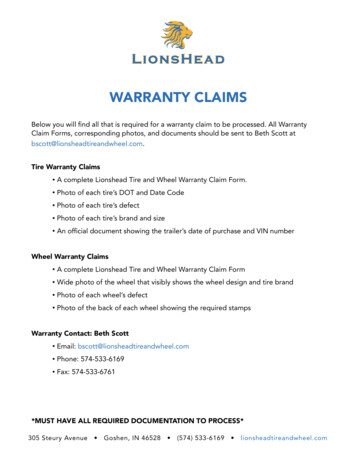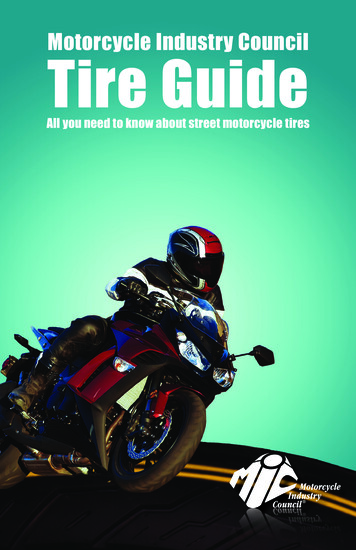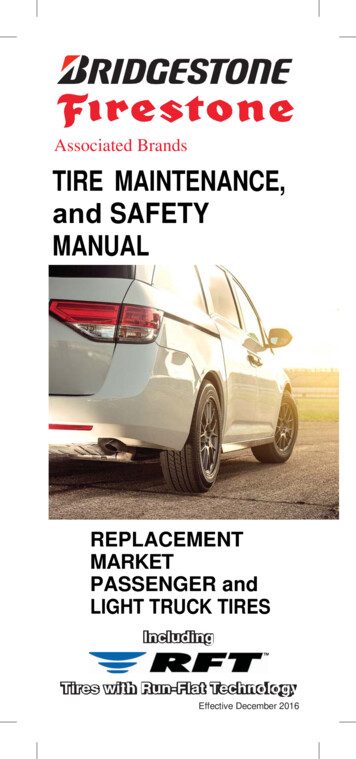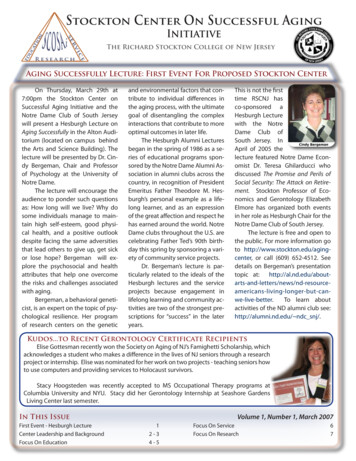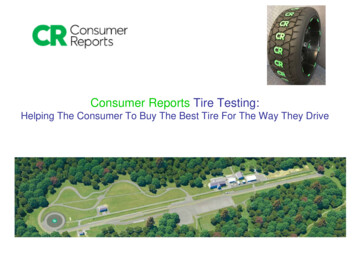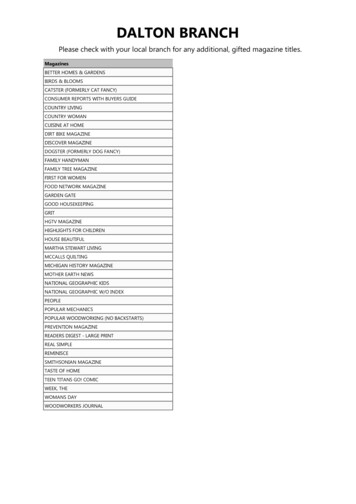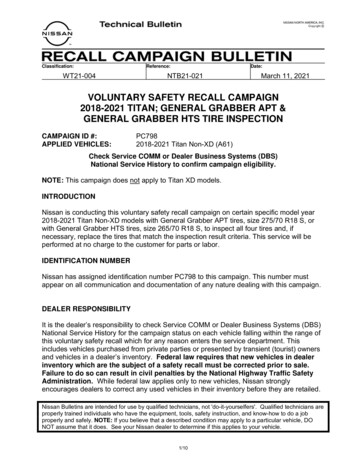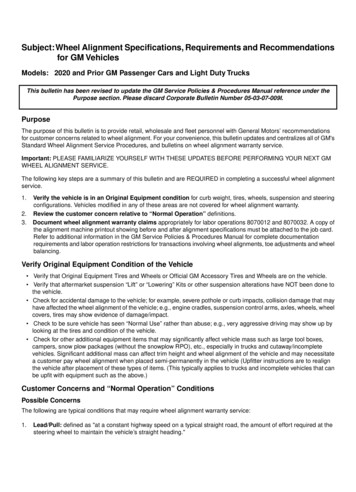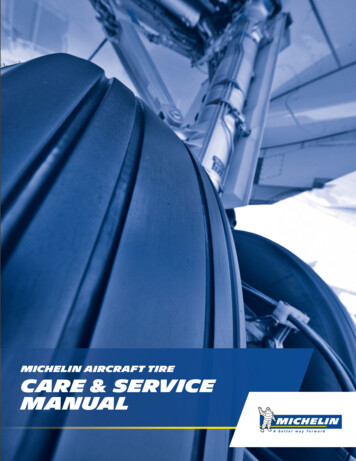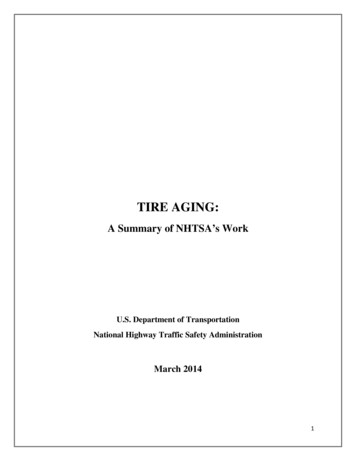
Transcription
TIRE AGING:A Summary of NHTSA’s WorkU.S. Department of TransportationNational Highway Traffic Safety AdministrationMarch 20141
TABLE OF CONTENTI.EXECUTIVE SUMMARY. 3II.INTRODUCTION . 7III.BACKGROUND . 10IV.SAFETY PROBLEM. 13A. Agency’s tire-related crash data. 13B. Agency’s tire aging-related crash data . 14C. Weather effect on tire performance . 16V.AGENCY’S RESEARCH. 19A. Research before FMVSS No.139. 19Field Study . 19Aging methods evaluation . 21Tire aging method refinement . 22Validation testing . 23B. Research after FMVSS No.139. 25VI.OBSERVATIONS . 27VII.CONCLUSIONS. 29Appendix A . 31Appendix B . 32Appendix C . 33Appendix D . 34Appendix E . 36Appendix F. 382
I.EXECUTIVE SUMMARYTire aging is a phenomenon involving the degradation of the material properties of a tirewhich overtime can compromise its structural integrity and jeopardize its performance. Tireaging takes place whether a tire is driven or not and for this reason is a concern for spare tiresand tires that are not regularly driven. The effect of aging may not be visibly detectable on thesetires and their integrity may be compromised even though they could be showing a great deal ofremaining tread.The current light vehicle tire standard, Federal Motor Vehicle Safety Standard (FMVSS)No.139; “New pneumatic radial tires for light vehicles” does not include a test to evaluate therisk of tire failure due to aging during a tire’s service life. 1Before FMVSS No.139 became effective, the agency conducted several phases of researchleading the development of the agency’s tire aging protocol 2, including a field study, agingmethods evaluation, tire aging method refinement and validation testing on pre-FMVSS No. 139tires. FMVSS No. 139-compliant tires were evaluated in the last phase of research to the tireaging test protocol developed in the previous phases.The last phase of research showed that the group of FMVSS No.139-complaint tires ovenaged following our current aging protocol presented an improved performance in the roadwheeldurability test when compared with the group of pre-FMVSS No. 139 tires that were previouslytested following the same protocol. Pre-FMVSS No. 139 tires developed more severe failure1The National Highway Traffic Safety Administration (NHTSA) was asked by members of Congress to consider thefeasibility of requiring a tire aging test during the hearings that preceded the enactment of the Transportation Recall,Enhancement, Accountability, and Documentation (TREAD) Act (H.R. 5164, Pub. L. No. 106-414, Nov. 1, 2000).Congress suggested this test to evaluate the risk of failure at a period later in the life of a tire than the currentregulation, which only evaluates new ;D NHTSA-2005-21276-00293
modes 3 when subjected to the endurance and low pressure test than FMVSS No.139-complianttires did, with the latter developing mostly cracks.NHTSA research also found that especially in the warmer parts of the United States,including Arizona, Florida, Texas and Southern California, there appears to be a relationshipbetween the age of the tire and the propensity of the tire to fail.Our most recent analysis on NASS-CDS 4 tire-related crash 5 data from 2007 through 2010shows a 35 percent reduction in tire crashes (17,019 to 11,047), a 50 percent reduction infatalities (386 to 195) and a 42 percent reduction in injuries (11,005 to 6,361) when comparedwith annual averages from 1995 through 2006. The overall fatalities decreased by 20 percentbetween 2007 and 2010 (dropping from 41,059 to 32,885 fatalities), and overall police reportedcrashes decreased by 10 percent between 2007 and 2010 (dropping from 6,024,000 to5,419,000).The agency believes that the more stringent FMVSS No. 139 has helped create better-qualityand safer tires. This change in light vehicle tire performance may be one of the reasons thepercentage of tire-related crashes, injuries and fatalities, has decreased in the 2007-2010 timeframe, since FMVSS No. 139 became effective on September 1, 2007. Another reason may bethat the number of vehicle crashes due to tire failures from under-inflation has decreased since3Failure modes that will result in non- compliance under FMVSS No.139 (visual evidence of tread, sidewall, ply,cord, inner liner, or bead separation, chunking, broken cords, cracking, or open splices, and the tire pressure is lessthan the initial test pressure). The agency has not provided pass/fail criteria for the oven aging protocol.4The National Automotive Sampling System - Crashworthiness Data System5The NASS-CDS contains on its General Vehicle Form the following information: a critical pre-crash event, vehicleloss of control due to a blowout or flat tire. In 2009, NHTSA changed its selection of crashes involving vehiclesmore than 10 years old. Adjustments were made in this analysis for older vehicles in 2009 and 2010 data so that wehad comparable data from 2007 to 2010.4
all new light vehicles were required to have tire pressure monitoring system (TPMS) startingSeptember 1, 2007 (FMVSS No.138).An improved roadwheel performance of oven-aged FMVSS No. 139-compliant tires whencompared to oven-aged pre-FMVSS No. 139 tires and an overall reduction of tire-related crasheshave lessened the tire aging concerns since the TREAD Act was enacted.At this time, the agency does not believe it is necessary for motor vehicle safety to add a tireaging requirement to its light vehicle tire standard due to the following reasons: First, FMVSSNo.139 has contributed to an increased robustness of oven-aged light vehicle tires. Our researchhas shown that oven-aged FMVSS No. 139-compliant tires are more resistant to degradation thanoven-aged pre-FMVSS No. 139 tires. Second, light vehicle tires are performing better on theroad as reflected in our most recent crash data. Third, a mandatory TPMS on light vehicle tiressince 2007 has helped alert consumers to under-inflation that is also known to degrade tiresfaster.Tire aging is still a concern in the more southern parts of the Sun Belt states 6, during thesummer months when heat build-up can cause a failure. Spare tires remain a concern as well,since they are not replaced regularly and may still show enough tread, even though the structuralintegrity of the tire may be compromised by aging. Adding to this concern, spare tires are oftenrotated into use and are sold as used tires.For the reasons stated above, the agency is coordinating a promotional and educationalinitiative to raise consumer awareness about tire aging issues and how to prevent these types offailures. Campaign initiatives and outreach efforts to consumers, partners and the automotive6Southern California, Arizona, New Mexico, Texas, Louisiana, Mississippi, Alabama, Georgia, and Florida5
service industry will include social media messages, fact sheets, infographics, and other webcontent.6
II.INTRODUCTIONTire aging is a phenomenon involving the degradation of the material properties of a tirewhich overtime can compromise its structural integrity and jeopardize its performance. Whenaging occurs, tires are more prone to failure, which could, at best cause an inconvenience, or atworst lead to a motor vehicle crash.The effect of aging may not be visibly detectable. Tire aging takes place whether a tire isdriven or not and its structural integrity may be compromised even though they could beshowing a great deal of remaining tread. Traditionally, the consumer judges the end of servicelife of a tire to be independent of tire age and defined as the point when the tread wears down tothe 2/32” tread wear indicator bar molded in the tread. Therefore, spare tires, and other tires thatare not regularly used, seldom get replaced and their structural integrity may be weakened eventhough the tires show a great deal of remaining tread.The aging mechanisms that are most likely to affect the relative safety of a tire are chemicaland mechanical in nature. Chemical aging occurs due to the combined effect of heat and oxygenon the rubber compound and mechanical aging results from the stresses and strains that a tireincurs during its normal use.Environmental conditions like heat and oxygen are known to deteriorate the materialproperties of the tires and affect their durability in service. NHTSA research shows thatespecially in the warmer parts of the United States, including Arizona, Florida, Texas andSouthern California, there appears to be a relationship between the age of the tire and the7
propensity of the tire to fail 7. These tire failures can result in motor vehicle crashes. From 1995to 2006, NHTSA estimates that about 386 fatalities annually may be attributed to tire failures ofall types 8. Tire aging failures tend to appear in the high heat states, in the summer months,during the day, while the vehicle is being driven at highway speeds. All of these factors make itmore difficult for the tire to dissipate heat, and heat build-up is the main factor in these types offailures.Tire failures can be caused by a number of factors such as under- or over- inflation of thetire, overloading of vehicles, road hazards, improper maintenance, structural defects, improperinstallation and tire aging. One common belief is that tire failures are caused by poormaintenance. Proper tire maintenance is important for good wear and the safety performance ofa tire, but tire aging is a degradation phenomenon that can occur due to the chemical reactionwithin the rubber components with oxygen and heat. This is different from inadequate inflationand maintenance problems. Some vehicle manufacturers recommend that tires be replaced everysix years regardless of use and a number of tire manufacturers recommend 10 years as themaximum service life for a tire because aging can affect the performance of the tires even if theyhave adequate tread and proper inflation.It is difficult to estimate how many crashes are caused specifically by tire aging. Based onanalysis of data from 2005 to 2006, NHTSA estimates that with pre-FMVSS 139 tires, 90fatalities and over 3,200 injuries occurred annually as the results of crashes that were probablycaused by tire aging or where tire aging was possibly a significant factor 9.7http://www.regulations.gov/#!documentDetail;D NHTSA-2005-21276-0055 Data has been collected in these fourspecific states, but we see no reason that other more southern sun belts states wouldn’t have similar issues.8NHTSA’s NASS-CDS database9Estimates are based on analysis of three different databases (NMVCCS, NASS-GES and NASS-CDS).8
The current standard for light vehicle tires, FMVSS No.139, does not include a test that couldevaluate the risk of tire failure at a period later in a tire’s service life. NHTSA has developed anoven-aging test for light vehicle tires which simulates age-related tire degradation. The agencytested tires before FMVSS No. 139 was effective and after to this new protocol. The testing ofFMVSS No.139-complaint tires showed an improvement in roadwheel performance after ovenaging.This report summarizes the work and research the agency has done to address the safetyproblem of tire degradation due to age and the agency’s plan to follow to bring awareness toconsumers and the general public about this safety issue.9
III.BACKGROUNDThe U.S. House of Representatives’ Committee on Energy and Commerce conductedhearings in late 2000, regarding the fatalities and injuries resulting from the tread separationfailures of Firestone Radial ATX, Radial ATX II, and Wilderness AT tires on specific models ofFord, Mercury, and Mazda light trucks and SUVs. At the time, members of Congress expressedconcern that the then-current light vehicle tire standard only tested new tires and did not evaluatehow well tires perform at a period later in their life and asked the agency to consider thefeasibility of including an aging test. It was believed at the time that if such an aging methodwas successful, then the light vehicle tires could eventually be required to meet a standard thatwould make them more resistant to operational degradation and possibly reduce their failure rateduring normal highway service.The TREAD Act 10 was enacted on November 1, 2000, as a consequence of the Committee’sactions and Congress instituted two major tire related initiatives at NHTSA with the Act. Onewas an upgrade of the two Federal Motor Vehicle Safety Standards for light passenger vehicletires to require increased performance requirements for new tires. The second was a requirementfor a tire pressure monitoring system (TPMS) on all new light vehicles. These two initiativesstrived to improve two somewhat related tire problems (in-service structural failures and underinflation).The first initiative required NHTSA to revise and update the passenger and light truck tirestandards, FMVSS No. 109; New pneumatic and certain specialty tires and No.119; Newpneumatic tires for motor vehicles with GVWR of more than 4,536 kilograms (10,000 pounds)10H.R. 5164, Pub. L. No. 106-41410
and motorcycles. The second initiative resulted in FMVSS No. 138; Tire pressure monitoringsystems. The FMVSS No. 138 addresses under-inflation and became effective September 1,2007.To address Congress’ tire aging concerns, the agency introduced three alternative tests forevaluating passenger vehicle tires’ long term durability or aging tests on the March 5, 2002NPRM for the new light vehicle tire standard. These alternatives included a peel strength test, anextended duration roadwheel endurance test, and an oven-aging test followed by a roadwheelendurance test.Based on the agency’s initial evaluation, as well as comments and data received fromindustry after the NPRM was published, the agency decided to defer action on the proposal ofadding an aging test to the new standard. The FMVSS No. 139, the current and more stringentpassenger vehicle tire standard was published on June 26, 2003 and does not include a tire agingtest requirement. This new standard unifies regulation for passenger and light truck tires thatwere previously regulated under FMVSS No. 109 and FMVSS No. 119, respectively.The lack of industry uniform approach to tire aging and the need to develop a laboratorybased accelerated service life test as well as having a better understanding of service-related tiredegradation prompted the agency to start its own tire aging research.On August 10, 2005, the president signed into law the Safe, Accountable, Flexible, EfficientTransportation Equity Act: A Legacy for Users (SAFETEA-LU). The SAFETEA-LU directedthe Secretary of Transportation to submit a report to Congress by August 2007 on researchconducted to address tire aging, and a summary of findings and recommendations.11
The Report to Congress 11 defined the safety problem, included a summary of the tire agingresearch and a list of items the agency needed to complete before deciding whether to pursuerulemaking. The agency reported that three aging protocols submitted by industry wereconsidered. Two of the accelerated tire aging methods subjected new tires to an indoorroadwheel for long durations to accelerate the tire aging process, structurally degrade the tires,and evaluate the tires’ performance. The third tire aging method was oven-aging, whichsubjected new tires, inflated with an oxygen-enriched gas, to elevated temperatures in an ovenfor an extended period of time. The oven-aged tires were then subjected to roadwheel tests. Thereport also stated that NHTSA research found that artificially aging a tire in a laboratory oven isa scientifically valid method to accelerate the tire aging process and to simulate a naturally agedtire in service on a vehicle.The agency continued its research after the Report to Congress was released, finalizing anoven-aging test procedure 12 and publishing a report that summarizes the performance of FMVSSNo. 139-compliant tires to the agency’s oven-aging test protocol 13.11http://www.regulations.gov/#!documentDetail;D documentDetail;D #!documentDetail;D NHTSA-2005-21276-00701212
IV.SAFETY PROBLEMA. Agency’s tire-related crash dataThe agency examined its crash data files to gather available information on tire-relatedproblems causing passenger vehicle crashes. The National Automotive Sampling System Crashworthiness Data System (NASS-CDS) uses trained investigators to collect data on a sampleof tow-away light vehicle crashes around the country. These data can be extrapolated to nationalestimates. NASS-CDS data from 1995 through 2006 (see table below) shows an estimated 17,019 tow away crashes caused per year by “blowouts or flat tires”, 386 fatalities and 11,005 nonfatal injuries were found in these tow-away crashes.Table 1: Light Vehicle Tire-related Crashes, Fatalities and Injuries(Annual ,047Fatalities386195Injuries11,0056,361NHTSA’s most recent study on tire-related crash data since the Report to Congress wasissued was an analysis on NASS-CDS data from 2007 through 2010. This analysis shows a 35percent reduction in tire crashes (17,019 to 11,047), a 50 percent reduction in fatalities (386 to195) and a 42 percent reduction in injuries (11,005 to 6,361). The overall fatalities decreased by20 percent between 2007 and 2010 (dropping from 41,059 to 32,885 fatalities), and overall13
police reported crashes decreased by 10 percent between 2007 and 2010 (dropping from6,024,000 to 5,419,000). It is important to note that the new, more stringent, tire standard forlight vehicles tires FMVSS No. 139 became fully effective on September 1, 2007 and also allnew light vehicles were required to have TPMS starting September 1, 2007.B. Agency’s tire aging-related crash dataNHTSA turned to its National Motor Vehicle Crash Causation Study (NMVCCS) database todetermine the number of tire aging cases occurring annually. These are crashes examined by ourtrained crash investigators that were collected from July 2005 to July 2007. Our investigatorslearned about these crashes when emergency medical services (EMS) were dispatched. Theyarrived on the scene and tried to determine the causal factors leading up to the crash. During thisprocess they took pictures of the tires, measured tread depth, took inflation pressures, made ascene diagram, and noted those cases in which the tires were considered the critical reason forthe crash and the last causal factor leading up to the crash.From these NMVCCS cases, all tread separations and sidewall separations (the way that tiresmight potentially fail due to factors related to tire aging) were examined. A total of 50 cases inNMVCCS were found with tread separations or sidewall separations. These 50 cases wereexamined by a team of NHTSA tire and crash causation experts trying to determine whether tireaging was not a factor at all in the case, an unlikely cause of the crash, possible cause of thecrash, or probable cause of the crash. The factors we examined, included the age of the tire(when a TIN was available), the age of the vehicle, what the tire looked like in the crash scenephotographs (to determine how it failed), tire pressure (could be too high or too low) in that tireor other tires of the vehicle (in some cases of tread separation, the tire retained pressure), whether14
all the tires on the vehicle were the same, or different brand / size, the mileage of the vehicle, thetread depth, whether the tire appeared to have been properly maintained, if, in the driverinterview, the tire had recently been a spare tire, and was the tire recalled for a defect, etc. Theteam found that 16 cases could potentially be tire aging related. From these analyses the teamdetermined that tire aging was the “probable” cause of 3 crashes, tire aging was a possible causeof 12 crashes and in 1 case the team could not determine if it was “possible or probable”.In determining the possibility that tire aging was a factor in the crash, we did not use the areaof the country the crash occurred in or the area of the country the vehicle was from. However, inthe 16 cases we decided were potentially or possibly related to tire aging, there were 5 from thesouthwestern Arizona area (which included some vehicles registered in California), 5 fromFlorida, 4 from Southern California, 1 from Texas and 1 from North Carolina. So, 15 out of 16were from high heat states. NMVCCS did not collect data in all 50 states, but from arepresentative sample of locations. Appendix D provides the NMVCCS cases examined.The agency also looked at the available 2005 and 2006 data in NASS-CDS and NASS-GES 14databases where blowout/flat tires was a causal factor (all three data sources have the samedefinition for blowout/flat tires and causal factors) and applied the same percentage found inweighted NMVCCS (23.2%) to be tire aging related to the NASS counts to estimate nationalfigures for tow-away crashes and police reported crashes. Using this method, we can estimatehow many possible or probable tire aging cases would have occurred if we had the samereporting in those NASS files as in NMVCSS.14National Automotive Sampling System – General Estimated System15
Based on analyses of data from 2005-2006 (all of these tires were manufacturer beforeFMVSS 139 took effect), the agency estimates that 90 fatalities and over 3,200 injuries occurredannually as the result of crashes that were probably caused by tire aging or where tire aging waspossibly a significant factor 15.Table 2: Light Vehicle Tire-related Crashes, Fatalities and InjuriesPossibly Caused by Tire Aging – Pre-FMVSS 139 Tires(Annual Averages)NMVCCS – NASS2005-2006Fatalities90Injuries3,200C. Weather effect on tire performanceAverage ambient air temperature also plays an important role in the likelihood of tirefailures. The agency determined from field reports that in Ford Explorer crashes involvingFirestone tires prior to February 2001, about 85 percent of the injuries and about 90 percent ofthe fatalities occurred in the Sun Belt states, with 68 percent of the fatalities occurring inCalifornia, Arizona, Texas, and Florida.This trend was also observed in NHTSA’s analysis of data provided by a large insurancecompany that shared its insured tire claims reported to its hotline from 2002 through 2006 withNHTSA 16. It reported that 27 percent of its policy holders are from Texas, California, Louisiana,Florida, and Arizona, but 77 percent of the tire claims came from these states and 84 percent of15This method resulted in an estimated 90 fatalities and 2,550 injuries on average in 2005 and 2006. In addition weconsidered unreported crashes, which added 660 injuries.16Report to Congress: http://www.regulations.gov/#!documentDetail;D NHTSA-2005-21276-004216
these involved tires over six years old. While tire insurance claims are not necessarily anabsolute measure of the failures 17 due to aging, it is reasonable to assume that a considerablenumber of insurance claims for tire adjustments in the four states listed combined with NHTSA’sfatality data and NMVCCS data given above is an indication that a large number of tire failuresare likely occurring because of the effect of sustained high temperature on tires.The trend was observed again in a study by the Rubber Manufacturers Association (RMA) 18,in which scrap tires in Arizona, California, Florida, Pennsylvania, Massachusetts, Oregon, andIllinois were examined. The results of the RMA study were somewhat obscured in that structuralfailures of the tires and road hazard damage were not separately coded. For instance, a tire witha full tread separation and a tire with a nail in the tread were both coded as having “treaddamage”. Therefore, trends for tire structural failures, which are infrequent events, are lost in thevast numbers of road hazard incidents. Additionally, vehicles involved in a tire-related trafficcrash serious enough to cause injury or death were not likely to be taken to a tire retailer postcrash for new tires. The failed tire(s) usually are retained by the insurance company or legalcounsel rather than returning to the retailer for an adjustment or replacement. Therefore it isvery unlikely that tires causing serious crashes would be found in the scrap tire stream examinedby the RMA. Nonetheless, the study showed that after four years, the rate of “tire damage” wassignificantly greater in Arizona, than in the other states and that in almost every case, tires fromthose states with higher average ambient temperatures had higher rates than states with loweraverage ambient temperatures.17With a sufficiently high applied stress or strain, every material is subject to failure. In use, tire materials aresubjected to the effects of fatigue, wear, heat, corrosion, and other external damage. The magnitude and frequencyof externally applied forces and moments can ultimately cause rubber to fatigue and tear or cause steel and polyestercords to rupture. The process of tire structural failure can progress slowly, or be essentially immediate; it dependsupon the structure itself, the magnitude and rate of imparted energy, and external conditions such as temperature.Taken from maticTire entDetail;D NHTSA-2005-21276-001517
Thus, the research findings suggest that tires age faster in regions with higher ambienttemperatures, and that low tire pressure was not the only failure mechanism at work. This issupported by the fact that NHTSA’s tire pressure surveys of over 11,500 vehicles 19 did not showincreased numbers of underinflated tires in Texas, Oklahoma, Louisiana, and Florida, relative tothe rest of the country. Nor is the agency aware of any evidence that these states possess harsherroads, or have more road debris than other pdf18
V.AGENCY’S RESEARCHNHTSA started its tire aging research in 2002 when the agency decided to defer action on theproposed addition of an aging test to the new FMVSS No.139 20. The main goals of the researchwere to develop an accelerated, laboratory-based tire aging test for new tires suitable forregulatory purposes and to evaluate tire safety performance after aging. Before FMVSS No.139became effective, several phases of research were conducted, including a field study, agingmethods evaluation, tire aging method refinement and validation testing on pre-139 tires. AfterFMVSS No.139 became effective, 139-compliant tires were evaluated to the tire aging testprotocol developed in the previous phases.A. Research before FMVSS No.139Field Study21The first objective of the research was to develop a better understanding of service-relatedtire degradation over time. In order to do so, the agency studied how tires change during actualservice as measured by changes in their roadwheel performance levels and quantitative materialproperties when compared to new versions of each tire. Since the rate of degradation of tirerubber components increases with temperature, NHTSA expected that the “worst case” tires inservice in the United States would be found in the relatively hotter Sun Belt States. It wasthought that designing a tire aging test to simulate service in a severe environment t
These tire failures can result in motor vehicle crashes. From 1995 to 2006, NHTSA estimates that about 386 fatalities annually may be attributed to tire failures of all types. 8. Tire aging failures tend to appear in the high heat states, in the summer months, during the day, while the vehicle is being driven at highway speeds.
